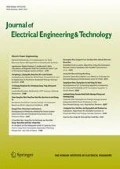Abstract
The availability of zero-sequence current, under normal circumstances, determines the accuracy of the operation of a distance relay which is connected to a mutually coupled parallel line. When this is not available, the system adopts a different compensation factor which if, not properly calculated introduces errors in the relay operation. The proposed adaptive protection scheme, described in this paper, consists of three modular artificial neural networks model (ANN). This is developed using the feed-forward nonlinear backpropagation Levenberg–Marquardt algorithm that determines the actual status of the mutually coupled lines. The remote terminal units connected to the current and voltage transformers are used to acquire the appropriate data. The proposed scheme also carefully determines the ground distance element reach settings by calculating the apparent impedance while considering mutual coupling for all practical system configurations from the ANN; this eliminates the need for a compensation factor. The results of the apparent impedance (R + jX) calculated by the proposed adaptive and the conventional schemes, showed an average percentage error of (0.06% and 0.02%) and (15% and 41.5%) respectively. Having obtained this result, the performance of the proposed adaptive scheme showed the exact fault location with a higher accuracy when compared with a compensated conventional scheme.












Similar content being viewed by others
References
Abilash GP, Ranjan A (2017) Review: double circuit transmission line protection techniques. Int J Adv Res Innov Ideas Educ 3(3):2973–2978
Yi Hu, Novosel D, Mohansaha M (2002) An adaptive scheme for parallel-line distance protection. IEEE Trans Power Deliv 17:105–110
Srivani SG, Vittal KP (2009) Three-zone quadrilateral adaptive distance relay for the protection of parallel transmission line with mutual coupling. J Electr Eng. https://doi.org/10.1109/ICIT.2009.4939541
Srivani SG, Reddy CA, Vittal KP (2008) Comparative evaluation of adaptive and conventional distance relay for parallel transmission line with mutual coupling, World Academy of Science, Engineering and Technology. Int J Electr Comput Eng 2(6):1168–1174
Sharifzadeh M, Sanaye-Pasand M (2007) An adaptive distance scheme for double circuit line protection. Universities Power Engineering Conference (UPEC), 2007, pp. 310–315
Eissa MM, Malik OP (2004) Laboratory Investigation of a distance protection technique for double circuit lines. IEEE Trans Power Deliv 19:1625–1635
Mclaren PG, Fernando I, Liu H, Dirks E, Swift GW, Steele C (1997) Enhanced double circuit line protection. IEEE Trans Power Deliv 12:1100–1108
Osman AH, Malik OP (2004) Protection of parallel transmission line using wavelet transform. IEEE Trans Power Deliv 19(1):49–55
Pasand MS, Jafarian P (2011) Adaptive protection of parallel transmission lines using combined cross-differential and impedance-based techniques. IEEE Trans Power Deliv 26(3):1829–1840
Bouthiba T (2004) Fault location in EHV transmission lines using artificial neural networks. Int J Appl Math Comput Sci 14(1):69–78
Sanaye-Pasand M, Khorashadi Z (2003) Transmission line fault detection and phase selection using ANN. In: International Conference on Power Systems Transients–IPST 2003 in New Orleans, USA.
Zaki DA, El-Amary NH, Abdelaziz AY, Mohammad M (2012) Adaptive distance protection of parallel transmission line. Int J Ind Eng Pract 4:45–62
Anamika J, Thoke AS, Patel RN (2009) Fault classification of double circuit transmission line using artificial neural network. Intern J Electr Comput Electr Eng 1(2):1793–8163
Mazon AJ, Zamora I, Minambres JF, Zorrozua MA, Barandiaran JJ, Sagastabeitia K (2000) A new approach to fault location in two-terminal transmission lines using artificial neural networks. Electr Power Syst Res J 56:261–266
Phadke AG, Thorp JS (2009) Computer relaying power systems. John Wiley and Sons Ltd, Amsterdam
Author information
Authors and Affiliations
Corresponding author
Additional information
Publisher's Note
Springer Nature remains neutral with regard to jurisdictional claims in published maps and institutional affiliations.
Rights and permissions
About this article
Cite this article
Uma, U.U., Ekwue, A. & Ejiogu, E. Adaptive Distance Protection Scheme for Mutually Coupled Line. J. Electr. Eng. Technol. 16, 131–140 (2021). https://doi.org/10.1007/s42835-020-00578-4
Received:
Revised:
Accepted:
Published:
Issue Date:
DOI: https://doi.org/10.1007/s42835-020-00578-4




